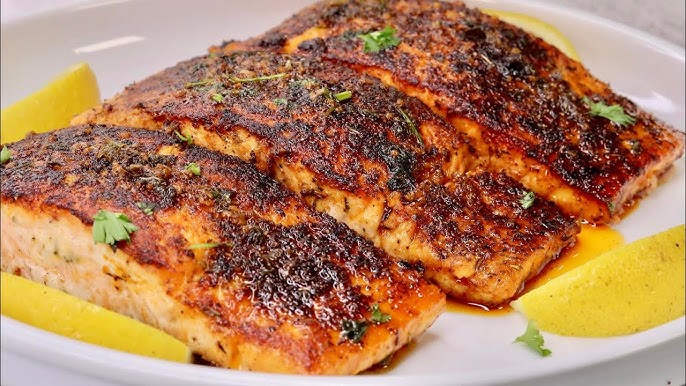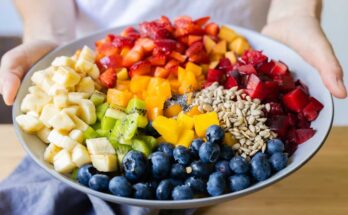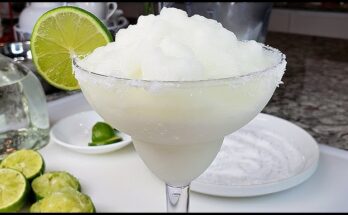Fried Salmon Recipe: If you’re craving something flavorful, quick, and packed with nutrients, then fried salmon should be on your dinner radar tonight. It’s the kind of dish that sounds fancy but is surprisingly easy to whip up—even if you’ve never cooked fish before. Golden and crispy on the outside, flaky and juicy on the inside, fried salmon is a total crowd-pleaser. Whether you’re making dinner for one or hosting friends, this recipe has your back. Stick around as we walk you through every single step from picking the perfect cut to plating up a masterpiece.
Why Fried Salmon Is a Must-Try Dish
Fried salmon checks off all the boxes. It’s fast (we’re talking under 20 minutes), full of flavor, and surprisingly versatile. You can enjoy it on a salad, with mashed potatoes, rice, veggies, or even tossed into a wrap or sandwich. Unlike baked or grilled versions, pan-frying gives you that irresistible crispy crust that seals in all the flavor. Plus, it makes your kitchen smell amazing. Seriously, if there’s a more satisfying sizzle than salmon hitting hot oil, we haven’t heard it. And the best part? You don’t need any fancy gadgets or pro-level skills—just a pan, some oil, and a hunger for something delicious.
Health Benefits of Eating Salmon
Let’s not forget—salmon is a superfood. It’s packed with omega-3 fatty acids, which are known to support heart and brain health. It’s also rich in high-quality protein, B vitamins, selenium, and potassium. Frying it in moderation doesn’t cancel out its health benefits. In fact, using a heart-friendly oil like avocado or canola can keep things balanced. Regularly adding salmon to your meals can help improve your cholesterol, reduce inflammation, and even support healthy skin. So yeah, you’re not just eating something tasty—you’re feeding your body what it craves.
Choosing the Right Type of Salmon
Wild-Caught vs. Farm-Raised Salmon
The kind of salmon you choose makes a big difference in taste and texture. Wild-caught salmon usually has a deeper red color, a firmer texture, and a more pronounced flavor. It’s leaner and considered more nutritious, but it’s also pricier. Farm-raised salmon tends to be lighter in color and fattier, which can actually make it juicier when frying. Either works fine—just know what you’re going for.
Best Cuts for Frying
Not all salmon cuts are created equal for frying. Fillets are your best bet. They cook evenly and give you that classic flaky texture. Go for skin-on fillets if you want a crispy crust. Center-cut fillets tend to be thicker and more uniform, which helps them cook more evenly in the pan.
Fresh or Frozen: Which Salmon Should You Use?
You might be surprised, but frozen salmon can be just as good as fresh—if not better—if it’s been flash-frozen. Always thaw your frozen fillets completely in the fridge before frying. Avoid defrosting in the microwave—it messes with the texture. If you’re using fresh salmon, make sure it smells clean and ocean-like, not fishy. The flesh should be firm and slightly springy to the touch.
Kitchen Tools You’ll Need for Frying Salmon
- Non-stick or stainless-steel skillet (cast iron works great too)
- Fish spatula (helps prevent tearing)
- Tongs (optional, but useful)
- Paper towels
- Sharp knife
- Mixing bowl (for seasonings)
- Meat thermometer (if you’re not confident eyeballing doneness)
Having the right tools makes the process smoother and helps you avoid overcooking or breaking the salmon apart while flipping.
Ingredients You’ll Need
Basic Ingredients
- 2 salmon fillets (6-8 oz each), skin-on
- Salt (to taste)
- Black pepper (freshly cracked)
- Garlic powder (1 tsp)
- Paprika (½ tsp)
- Lemon wedges (for garnish)
- 2–3 tablespoons of oil (avocado oil, canola, or grapeseed)
Optional Seasonings and Garnishes
- Fresh dill or parsley (chopped)
- Lemon zest
- Crushed red pepper flakes (if you like a kick)
- Old Bay seasoning or Cajun mix (for flavor twist)
- Butter (1 tbsp for basting at the end)
- Minced garlic or shallots (for added aroma)
How to Prep the Salmon Before Cooking
Before you even think about turning on the stove, proper prep is everything. Rinse your salmon fillets under cold water and gently pat them dry with paper towels. Moisture is the enemy of crispiness, so get them bone dry. Check for any tiny pin bones by running your fingers along the flesh, and use tweezers to pull them out if needed. If you want an extra flavor punch, rub the fillets with olive oil and your seasoning blend at least 15–30 minutes before cooking. This allows the flavors to penetrate. Keep the fish at room temperature for 10–15 minutes before frying—cold fish straight into hot oil can cause uneven cooking.
Best Oils for Frying Salmon
Not all oils are created equal—especially for frying. You want one with a high smoke point so it doesn’t burn and ruin the flavor.
Here are some solid options:
- Avocado oil: High smoke point and neutral flavor.
- Canola oil: Cheap, easy to find, and works great.
- Grapeseed oil: Clean taste and heats well.
- Vegetable oil: An affordable go-to.
- Olive oil (light, not extra virgin): Only for low to medium heat.
Avoid using butter alone—it’ll burn. But adding it toward the end for basting? That’s chef’s kiss.
Step-by-Step Guide to Frying Salmon Perfectly
Let’s break it down, step by step:
Step 1: Prep the Salmon
Pat your fillets dry again if needed. Season both sides generously with salt, pepper, garlic powder, and paprika.
Step 2: Season Generously
If you’re using extra flavors (like lemon zest or chili flakes), rub them in now. Don’t be shy—the crust is where all the flavor lives.
Step 3: Heat the Oil
Place your skillet over medium-high heat. Add 2–3 tablespoons of oil. Wait until the oil is shimmering, not smoking.
Step 4: Fry the Salmon Skin-Side Down
Gently place the fillets into the pan, skin-side down. You should hear a satisfying sizzle. Don’t move them—let them develop a golden crust.
Step 5: Flip Carefully
After 4–5 minutes (depending on thickness), use a fish spatula to flip. If the skin sticks, give it another 30 seconds. The key is patience.
Step 6: Check for Doneness
Cook the second side for 3–4 minutes. The inside should be opaque and flake easily. If you’re unsure, a meat thermometer should read 125°F for medium-rare.
Step 7: Rest and Serve
Remove from heat and let rest for a couple of minutes. Squeeze fresh lemon juice over the top and garnish with herbs.
Common Mistakes to Avoid When Frying Salmon
Frying salmon may seem foolproof, but there are a few classic mistakes that can turn your golden-crisp dinner into a dry or soggy mess. First off, don’t overcrowd the pan. If you’re cooking multiple fillets, give them space—otherwise, they’ll steam instead of fry. Another common error? Flipping too early. You’ve got to let the skin crisp and release naturally from the pan. If it’s sticking, it’s not ready to flip.
Also, don’t fry cold salmon straight from the fridge. Let it sit at room temperature for 10-15 minutes. This helps it cook more evenly. Overcooking is a biggie—salmon continues to cook a bit even after it’s off the heat, so aim for just-done and let it rest. And finally, don’t forget to dry the fish well before it hits the pan. Wet salmon equals soggy skin, and no one wants that.
What to Serve with Fried Salmon
Let’s talk about the fun part—what goes with this crispy beauty? Fried salmon is super versatile, so you’ve got tons of options.
Quick and Easy Side Dishes
- Garlic mashed potatoes – Creamy and comforting.
- Steamed or sautéed veggies – Think asparagus, broccoli, or green beans.
- Rice pilaf or herbed quinoa – Light and flavorful.
- Simple salad – Mixed greens, cucumbers, cherry tomatoes, lemon vinaigrette.
- Crispy roasted potatoes – Because more crispy is never a bad thing.
Sauces That Pair Well
- Tartar sauce – Classic and tangy.
- Garlic herb butter – Melt it over the top for extra indulgence.
- Dill yogurt sauce – Light and refreshing.
- Spicy mayo – A great match if you’re going for bold flavors.
- Chimichurri – For a fresh, herbaceous kick.
Mix and match to your heart’s content. This dish is a blank canvas waiting for your culinary creativity.
Storing and Reheating Fried Salmon
Got leftovers? Lucky you. Fried salmon stores pretty well if you do it right.
- Storing: Let the salmon cool completely before sealing it in an airtight container. Store in the fridge for up to 3 days.
- Freezing: You can freeze fried salmon, but keep in mind it may lose some texture. Wrap it tightly in plastic wrap and then foil, or use a vacuum sealer. Freeze for up to 2 months.
Reheating Tips:
- Oven method (best): Preheat to 300°F. Place salmon on a baking sheet and cover loosely with foil. Heat for about 10–12 minutes.
- Skillet method: Add a little oil or butter to a pan and reheat over medium-low. Cover and heat gently for 5–7 minutes.
- Microwave (least recommended): Use only if you’re in a hurry. Cover with a damp paper towel and heat in 30-second bursts to avoid drying it out.
Pro tip: Reheat low and slow to maintain moisture and texture.
Tips for Making the Crispiest Salmon Skin
If you’re like most salmon lovers, crispy skin is the crown jewel of a perfectly fried fillet. Here’s how to nail it every time:
- Pat it dry—twice. Use paper towels to remove as much moisture as possible.
- Score the skin. Lightly run a knife across the skin in shallow cuts. This helps prevent curling and ensures even contact with the pan.
- Use the right oil. Go for a high-smoke-point oil like avocado or canola.
- Get the pan hot. You want it shimmering, not smoking.
- Press it down gently. For the first minute, use a spatula to press the fillet down. This keeps it from curling up and helps the skin crisp evenly.
- Don’t flip too early. The skin needs 4–5 minutes to crisp properly.
Once it’s crispy, you’ll hear the crunch before you even taste it. That’s how you know you’ve done it right.
Fried Salmon Variations to Try
Want to change things up? There are tons of ways to tweak this recipe to match your mood or spice preferences.
- Asian-Inspired: Marinate with soy sauce, ginger, and sesame oil. Serve with stir-fried veggies and rice.
- Cajun Kick: Coat in Cajun spice blend and serve with remoulade sauce.
- Mediterranean Style: Season with oregano, garlic, and lemon. Serve with tzatziki and couscous.
- Sweet & Spicy: Glaze with honey and sriracha right after frying.
- Panko-Crusted: Dip in beaten egg, then coat with panko breadcrumbs before frying for extra crunch.
Experiment with flavors—it’s hard to go wrong with a base as good as fried salmon.
Nutritional Breakdown of Fried Salmon
Fried salmon is more than just delicious—it’s also nutrient-dense. Here’s a general breakdown for one medium fillet (approx. 6 oz), pan-fried in oil:
| Nutrient | Amount |
|---|---|
| Calories | 400–450 kcal |
| Protein | 35–40 grams |
| Total Fat | 25 grams |
| Saturated Fat | 4 grams |
| Omega-3 Fatty Acids | 2,000 mg+ |
| Carbohydrates | 0–2 grams |
| Cholesterol | 90 mg |
| Sodium (seasoned) | 300–400 mg |
| Vitamin D | 50–60% DV |
| Vitamin B12 | 100%+ DV |
| Selenium | 70–80% DV |
DV = Daily Value (based on 2,000-calorie diet)
It’s high in protein, loaded with heart-healthy fats, and naturally low in carbs—great for keto or low-carb diets.
FAQs about Fried Salmon Recipe
1. Can I use olive oil to fry salmon?
Yes, but choose light olive oil, not extra virgin. It has a higher smoke point and won’t burn as easily. For best results, use oils like avocado or canola.
2. How long does it take to fry salmon?
Depending on the thickness, it typically takes 4–5 minutes per side. Thinner fillets may cook faster, so keep an eye on it.
3. Do I need to marinate the salmon before frying?
It’s optional. A quick 15-minute marinade can add extra flavor, but simple seasoning works just fine. Just make sure it’s dry before frying.
4. How can I tell when salmon is cooked through?
It should be opaque, flake easily with a fork, and reach an internal temp of 125°F for medium-rare. A bit of translucency in the center is okay if you like it more tender.
5. What’s the best way to reheat leftover fried salmon?
The oven is your best bet. Preheat to 300°F, cover the salmon with foil, and heat for about 10 minutes. Avoid microwaving if possible.
Conclusion
Fried salmon is one of those magical dishes that somehow manages to be both elegant and easy. Whether you’re cooking for yourself or impressing guests, it brings the flavor, the texture, and the nutrition. The crispy skin, the flaky inside, and the endless options for customization make it a go-to recipe in any kitchen. With just a few ingredients and a hot skillet, you can turn a simple piece of fish into a dinner you’ll crave again and again.
Try it once, and it just might become your new weeknight hero.



